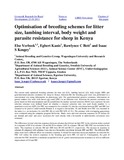| dc.contributor.author | Verbeek, Else | |
| dc.contributor.author | Kanis, Egbert | |
| dc.contributor.author | Bett, Rawlynce C | |
| dc.contributor.author | Kosgey, Isaac S | |
| dc.date.accessioned | 2013-06-18T13:39:31Z | |
| dc.date.available | 2013-06-18T13:39:31Z | |
| dc.date.issued | 2011 | |
| dc.identifier.citation | Verbeek, E et al(2011). Optimisation of breeding schemes for litter size, lambing interval, body weight and parasite resistance for sheep in Kenya. Livestock Research for Rural Development 23 (9) | en |
| dc.identifier.uri | http://lrrd.cipav.org.co/lrrd23/9/verb23187.htm | |
| dc.identifier.uri | http://erepository.uonbi.ac.ke:8080/xmlui/handle/123456789/35718 | |
| dc.description | Journal article | en |
| dc.description.abstract | The current study optimised breeding schemes for litter size (LS), lambing interval (LI), body weight (BW) and gastrointestinal parasite resistance for sheep in Kenya. Selection for the breeding goal traits was performed in a conventional way using information on phenotypes only. For gastrointestinal parasite resistance, information on genetic makers was used, with faecal egg count (FEC) as an indicator trait. Selection for parasite resistance was partly based on field measurements and the possibilities for marker-assisted selection (MAS) were explored. Several selection schemes were defined based on whether a classical selection only was used (Latin number 1), a quantitative trait loci (QTL) for FEC was assumed to be available (2), that the correlation between FEC and BW was assumed to be positive (unfavourable-Roman I) or negative (favourable- II) and finally how FEC was included in the index (i.e., no inclusion (A), with FEC (B) or with FEC QTL (C-F)). The schemes with overlapping generations were evaluated using the computer program SelAction. Rams, ewes and total selection responses in US dollars ($) per animal, and rams’ and ewes’ accuracies for each scheme with a favourable or unfavourable correlation were estimated.
The differences in total selection responses between schemes that did not include FEC in the selection index resulted in a response of $0.16 in scheme 1AI and $0.20 in scheme 1AII. In schemes 1BI and 1BII, FEC was included in the index. The responses in scheme 1BI and 1BII were $0.165 and $0.217, respectively. The increase in response in schemes II compared with schemes I was due to a favourable correlation between BW and FEC. The different FEC index traits had a different effect on economic response. It should be noted that increased emphasis on selection for FEC will reduce the relative responses to the breeding goal traits BW, LS and LI. Consequently, the goal of selection for FEC should be to maintain acceptable levels of gastro-intestinal parasite resistance as well as sufficient improvement of LS and BW. | en |
| dc.language.iso | en | en |
| dc.subject | Breeding programs | en |
| dc.subject | Gastro-intestinal parasite resistance | en |
| dc.subject | Sheep | en |
| dc.subject | Kenya | en |
| dc.title | Optimisation of breeding schemes for litter size, lambing interval, body weight and parasite resistance for sheep in Kenya | en |
| dc.type | Article | en |
| local.publisher | Department of Animal Production, University of Nairobi | en |

